Save Screen Image
Use this dialog tab to save an image of the display in a graphic file.
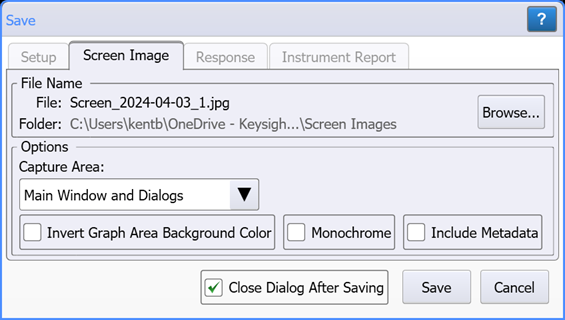
To save a screen image to a file
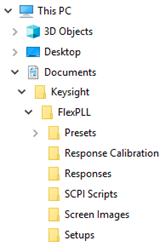
- In the Options field, select the options that you want. Each option is explained in this topic.
- Click Browse to change a target file name and folder that is different from the default.
- Click Save to save the file.
The default user data folder for saving screen images files is \Screen Images.
If a displayed dialog is outside FlexPLL's window, it will not be included in the screen image capture. Use the Windows Print Screen function instead.
File Names
After a default setup, the file name assigned to a screen capture file takes the form Screen_2017-04-08_1.jpg. An incremented number is automatically appended after the date field. With each subsequent file save, this number is incremented. Appending an autogenerated number helps to prevent the accidental writing over of an existing file.
If you click Browse, you can replace this automatically generated name with any name that you like. For example, my_file.jpg. In this case, the first file saved will be my_file.jpg. If you have cleared Close Dialog After Saving, the next file will have the characters "_1" appended as in my_file_1.jpg. This autonumber will automatically be increased on each subsequent save. If you select Close Dialog After Saving, the default file name reverts back to the form Screen_<date><autonumber> as described at the beginning of this section.
If you enter a file name that has an arbitrary number appended, for example this_file_57.jpg, FlexPLL will detect this and save the subsequent file as this_file_58.jpg.
Options
Capture Area
Selects the capture area on FlexPLL's window that will be saved into the screen image file.
| Main Window | Main Window and Dialogs | JTF Graph |
|---|---|---|
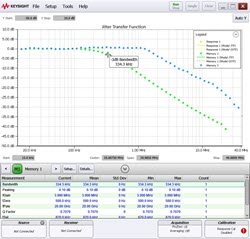
|
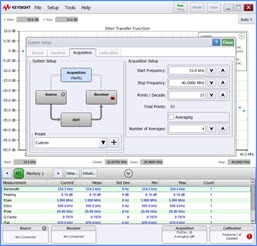
|
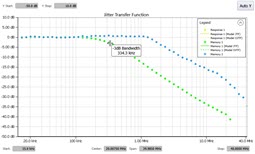
|
Invert Graticule Area Background Color Option
Saves the image with the graph's background color changed from black to white. The plot colors remain unchanged. Combined with the Aluminum display theme this setting is especially useful when printing a hard copy of the waveform as it saves ink or toner. If the Invert Graph Colors in the Display Setup dialog is selected, the JTF Graph's background is inverted from black to white regardless of the Invert Graticule Area Background Color setting.
Monochrome
Saves the screen as a black and white image.
Include Metadata
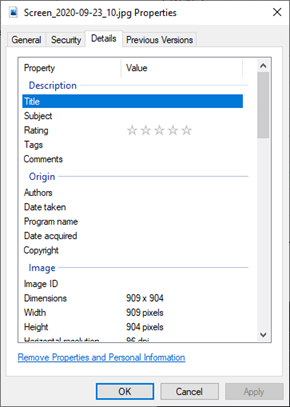
When Include Metadata is selected for a jpg or tiff file, additional metadata fields are added to the saved image file. Cameras and graphic editing applications often place metadata in a file, such as camera exposure settings or comments. FlexPLL can also add its own metadata to these two image types. By default, this option is turned off. If you plan to place you screen capture in a web page or informal document, a jpg image is the best selection. If you plan to print your screen capture or need maximum quality, save a tiff image. FlexPLL does not support saving metadata in the bmp, png, or gif file formats.
To view or edit the metadata placed in your screen image file, you can right click on the file in Window's File Explorer and from the shortcut menu select Properties. In the Properties dialog, click the Details tab as shown in this picture. Some of the metadata fields are editable such as comments. To edit, click on a Value entree. The following list shows the metadata fields that FlexPLL populates.
- Dimensions
- Width
- Height
- Horizontal resolution
- Vertical resolution
- Bit depth
- Name
- Date created
- Date modified
- Size
- Owner
- Computer
Available Graphics Formats
The filename extension indicates the image file format. In SCPI commands and queries, the format is selected or indicated in a programming message by the strings shown in this table.
| File Extension |
SCPI String |
Description |
|---|---|---|
| .bmp | BITMap
|
24-bit color symbol map file format. Bitmap, or .bmp, is typically used for storing symbol mapped graphic files. |
| .png | PNG
|
Portable Network Graphics) format that is not compressed. It is widely accepted and is a good choice for both documents and the web pages. |
| .jpg | JPG
|
24-bit color Joint Photographic Experts Group file format). .jpg is a graphics format that is compressed. This compression creates smaller files but may affect image quality. For example, data points may be erased due to the image compression. If file size is not an issue, use the .png format instead. The application uses the .jpg software written by the Independent JPEG Group. |
| .gif | GIF
|
Graphics Interchange File format. .gif is a standard graphics format (256 color) used to store symbol mapped graphic files. For .gif files, this application uses LZW compression/decompression licensed under U.S. patent No 4,558,302 and foreign counterparts. The purchase or use of LZW graphics capability in a licensed product does not authorize or permit an end user to use any other product or perform any other method or activity involving use of LZW unless the end user is separately licensed in writing by Unisys. End user should not modify, copy, or distribute LZW compression/decompression capability. |
| .tiff | TIFF
|
24-bit color Tag Image File format. .tif is a format of choice for storing images with lossless compression. It provides better quality, but larger files. This format is widely supported across platforms (PC, Mac, UNIX). This application uses LZW compression/decompression licensed under U.S. patent No 4,558,302 and foreign counterparts. The purchase or use of LZW graphics capability in a licensed product does not authorize or permit an end user to use any other product or perform any other method or activity involving use of LZW unless the end user is separately licensed in writing by Unisys. End user should not modify, copy, or distribute LZW compression/decompression capability. |